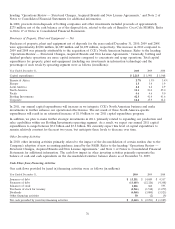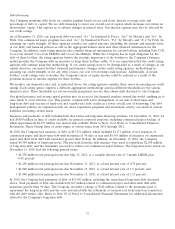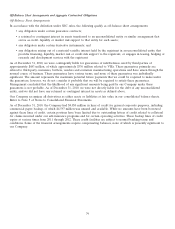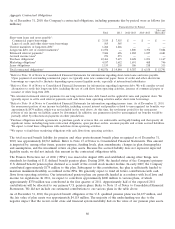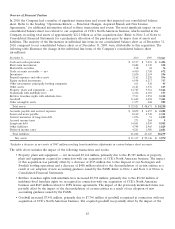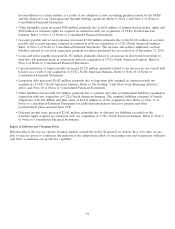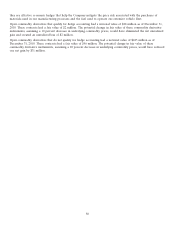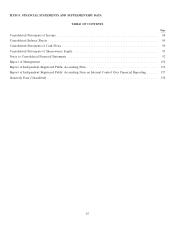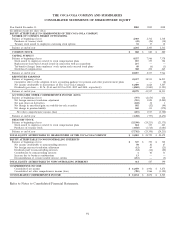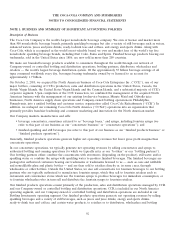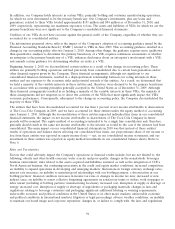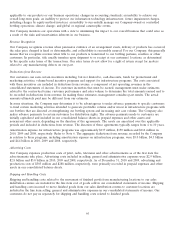Coca Cola 2010 Annual Report Download - page 87
Download and view the complete annual report
Please find page 87 of the 2010 Coca Cola annual report below. You can navigate through the pages in the report by either clicking on the pages listed below, or by using the keyword search tool below to find specific information within the annual report.ITEM 7A. QUANTITATIVE AND QUALITATIVE DISCLOSURES ABOUT MARKET RISK
Our Company uses derivative financial instruments primarily to reduce our exposure to adverse fluctuations in foreign
currency exchange rates, interest rates, commodity prices and other market risks. We do not enter into derivative
financial instruments for trading purposes. As a matter of policy, all of our derivative positions are used to reduce risk
by hedging an underlying economic exposure. Because of the high correlation between the hedging instrument and the
underlying exposure, fluctuations in the value of the instruments are generally offset by reciprocal changes in the value
of the underlying exposure. The Company generally hedges anticipated exposures up to 36 months in advance; however,
the majority of our derivative instruments expire within 24 months or less. Virtually all of our derivatives are
straightforward over-the-counter instruments with liquid markets.
We monitor our exposure to financial market risks using several objective measurement systems. In prior years, the
Company primarily used the value at risk methodology for its quantitative and qualitative disclosures about market risk.
However, with the Company’s acquisition of CCE’s North American business in 2010, and the related changes to our
consolidated balance sheet, the Company has provided a sensitivity analysis to measure our exposure to fluctuations in
foreign currency exchange rates, interest rates, and commodity prices. Refer to Note 5 of the Notes to Consolidated
Financial Statements for additional information about our hedging transactions and derivative financial instruments.
Foreign Currency Exchange Rates
We manage most of our foreign currency exposures on a consolidated basis, which allows us to net certain exposures
and take advantage of any natural offsets. In 2010, we generated approximately 70 percent of our net operating
revenues from operations outside the United States; therefore, weakness in one particular currency might be offset by
strengths in other currencies over time. We use derivative financial instruments to further reduce our net exposure to
currency fluctuations.
Our Company enters into forward exchange contracts and purchases currency options (principally euro and Japanese
yen) and collars to hedge certain portions of forecasted cash flows denominated in foreign currencies. Additionally, we
enter into forward exchange contracts to offset the earnings impact related to exchange rate fluctuations on certain
monetary assets and liabilities. We also enter into forward exchange contracts as hedges of net investments in
international operations.
The total notional value of our foreign currency derivatives was $6.3 billion and $4.6 billion as of December 31, 2010
and 2009, respectively. This total includes derivative instruments that are designated and qualify for hedge accounting as
well as economic hedges. The fair value of the contracts that qualify for hedge accounting resulted in a liability of
$109 million as of December 31, 2010. At the end of 2010, we estimate that an unfavorable 10 percent change in the
exchange rates would have increased our net unrealized losses by $395 million. Likewise, the fair value of the contracts
that do not qualify for hedge accounting resulted in a liability of $79 million, and we estimate that an unfavorable
10 percent change in rates would have increased our net losses by $244 million. All losses were offset by changes in the
underlying hedged item, resulting in no net material impact on earnings.
Interest Rates
We monitor our mix of fixed-rate and variable-rate debt, as well as our mix of short-term debt versus long-term debt.
From time to time, we enter into interest rate swap agreements to manage our mix of fixed-rate and variable-rate debt.
Based on the Company’s variable-rate debt and derivative instruments outstanding as of December 31, 2010, a
1 percentage point increase versus the market interest rates available on December 31, 2010 would result in an
additional $123 million of interest expense. However, the impact to our consolidated statement of income would have
been partially offset by the increase in interest income related to higher interest rates.
Commodity Prices
The Company is subject to market risk with respect to commodity price fluctuations, principally related to our
purchases of aluminum and plastic, sweeteners, and energy. Whenever possible, we manage our exposure to commodity
risks primarily through the use of supplier pricing agreements that enable us to establish the purchase prices for certain
inputs that are used in our manufacturing and distribution business. We also use derivative financial instruments to
manage our exposure to commodity risks at times. Certain of these derivatives do not qualify for hedge accounting, but
85



